Polymer-Particle Pressure-Sensitive Paint with High Photostability
Abstract
:1. Introduction
2. Pressure- and Temperature Sensitivities of PSP
3. Materials and Methods
3.1. Preparation of Polymer Particles
3.2. Preparation of pp-PSP
4. Results and Discussion
4.1. Pressure- and Temperature-Sensitivities of pp-PSP
4.2. Time Response Property of pp-PSP
4.3. Photostability of pp-PSP
5. Conclusions
Acknowledgments
Author Contributions
Conflicts of Interest
References
- Liu, T.; Sullivan, J.P. Pressure and Temperature Sensitive Paint; Springer: New York, NY, USA, 2005. [Google Scholar]
- Bell, J.H.; Schairer, E.T.; Hand, L.A.; Mehta, R.D. Surface pressure measurements using luminescent coatings. Annu. Rev. Fluid Mech. 2001, 33, 155–206. [Google Scholar] [CrossRef]
- Gregory, J.W.; Asai, K.; Kameda, M.; Liu, T.; Sullivan, J.P. A review of pressure-sensitive paint for high-speed and unsteady aerodynamics. Proc. Inst. Mech. Eng. Part G J. Aerosp. Eng. 2008, 222, 249–290. [Google Scholar] [CrossRef]
- Gregory, J.W.; Sakaue, H.; Liu, T.; Sullivan, J.P. Fast pressure-sensitive paint for flow and acoustic diagnostics. Annu. Rev. Fluid Mech. 2014, 46, 303–330. [Google Scholar] [CrossRef]
- Nagai, H.; Naraoka, R.; Sawada, K.; Asai, K. Pressure-sensitive paint measurement of pressure distribution in a supersonic micronozzle. AIAA J. 2008, 46, 215–222. [Google Scholar] [CrossRef]
- Matsuda, Y.; Uchida, T.; Suzuki, S.; Misaki, R.; Yamaguchi, H.; Niimi, T. Pressure-sensitive molecular film for investigation of micro gas flows. Microfluid. Nanofluidics 2011, 10, 165–171. [Google Scholar] [CrossRef]
- Matsuda, Y.; Nagashima, F.; Yamaguchi, H.; Egami, Y.; Niimi, T. Unsteady 2d measurement of dissolved oxygen distribution using luminescent sensor film. Sens. Actuators B Chem. 2011, 160, 1464–1467. [Google Scholar] [CrossRef]
- Huang, C.-Y.; Lai, C.-M. Pressure measurements with molecule-based pressure sensors in straight and constricted PDMS microchannels. J. Micromech. Microeng. 2012, 22. [Google Scholar] [CrossRef]
- Sakaue, H.; Gregory, J.W.; Sullivan, J.P.; Raghu, S. Porous pressure-sensitive paint for characterizing unsteady flowfields. AIAA J. 2002, 40, 1094–1098. [Google Scholar] [CrossRef]
- Kameda, M.; Tabei, T.; Nakakita, K.; Sakaue, H.; Asai, K. Image measurements of unsteady pressure fluctuation by a pressure-sensitive coating on porous anodized aluminium. Meas. Sci. Technol. 2005, 16, 2517–2524. [Google Scholar] [CrossRef]
- Egami, Y.; Ueyama, J.; Furukawa, S.; Kameya, T.; Matsuda, Y.; Yamaguchi, H.; Niimi, T. Development of fast response bi-luminophore pressure-sensitive paint by means of an inkjet printing technique. Meas. Sci. Technol. 2015, 26. [Google Scholar] [CrossRef]
- Juliano, T.J.; Kumar, P.; Peng, D.; Gregory, J.W.; Crafton, J.; Fonov, S. Single-shot, lifetime-based pressure-sensitive paint for rotating blades. Meas. Sci. Technol. 2011, 22. [Google Scholar] [CrossRef]
- Matsuda, Y.; Yorita, D.; Egami, Y.; Kameya, T.; Kakihara, N.; Yamaguchi, H.; Asai, K.; Niimi, T. Unsteady pressure-sensitive paint measurement based on the heterodyne method using low frame rate camera. Rev. Sci. Instrum. 2013, 84. [Google Scholar] [CrossRef] [PubMed]
- Sakaue, H.; Miyamoto, K.; Miyazaki, T. A motion-capturing pressure-sensitive paint method. J. Appl. Phys. 2013, 113. [Google Scholar] [CrossRef]
- Sakaue, H.; Kakisako, T.; Ishikawa, H. Characterization and optimization of polymer-ceramic pressure-sensitive paint by controlling polymer content. Sensors 2011, 11, 6967–6977. [Google Scholar] [CrossRef] [PubMed]
- Sakaue, H.; Hayashi, T.; Ishikawa, H. Luminophore application study of polymer-ceramic pressure-sensitive paint. Sensors 2013, 13, 7053–7064. [Google Scholar] [CrossRef] [PubMed]
- Kameda, M.; Seki, H.; Makoshi, T.; Amao, Y.; Nakakita, K. A fast-response pressure sensor based on a dye-adsorbed silica nanoparticle film. Sens. Actuators B Chem. 2012, 171/172, 343–349. [Google Scholar] [CrossRef]
- Pandey, A.; Gregory, J.W. Step response characteristics of polymer/ceramic pressure-sensitive paint. Sensors 2015, 15, 22304–22324. [Google Scholar] [CrossRef] [PubMed]
- Pandey, A.; Gregory, J.W. Frequency-response characteristics of polymer/ceramic pressure-sensitive paint. AIAA J. 2016, 54, 174–185. [Google Scholar] [CrossRef]
- Yabu, H. Self-organized precipitation: An emerging method for preparation of unique polymer particles. Polym. J. 2013, 45, 261–268. [Google Scholar] [CrossRef]
- Yabu, H. Creation of functional and structured polymer particles by self-organized precipitation (SORP). Bull. Chem. Soc. Jpn. 2012, 85, 265–274. [Google Scholar] [CrossRef]
- Matsuda, Y.; Torimoto, T.; Kameya, T.; Kameyama, T.; Kuwabata, S.; Yamaguchi, H.; Niimi, T. Zns-AglnS 2 nanoparticles as a temperature sensor. Sens. Actuators B Chem. 2013, 176, 505–508. [Google Scholar] [CrossRef]
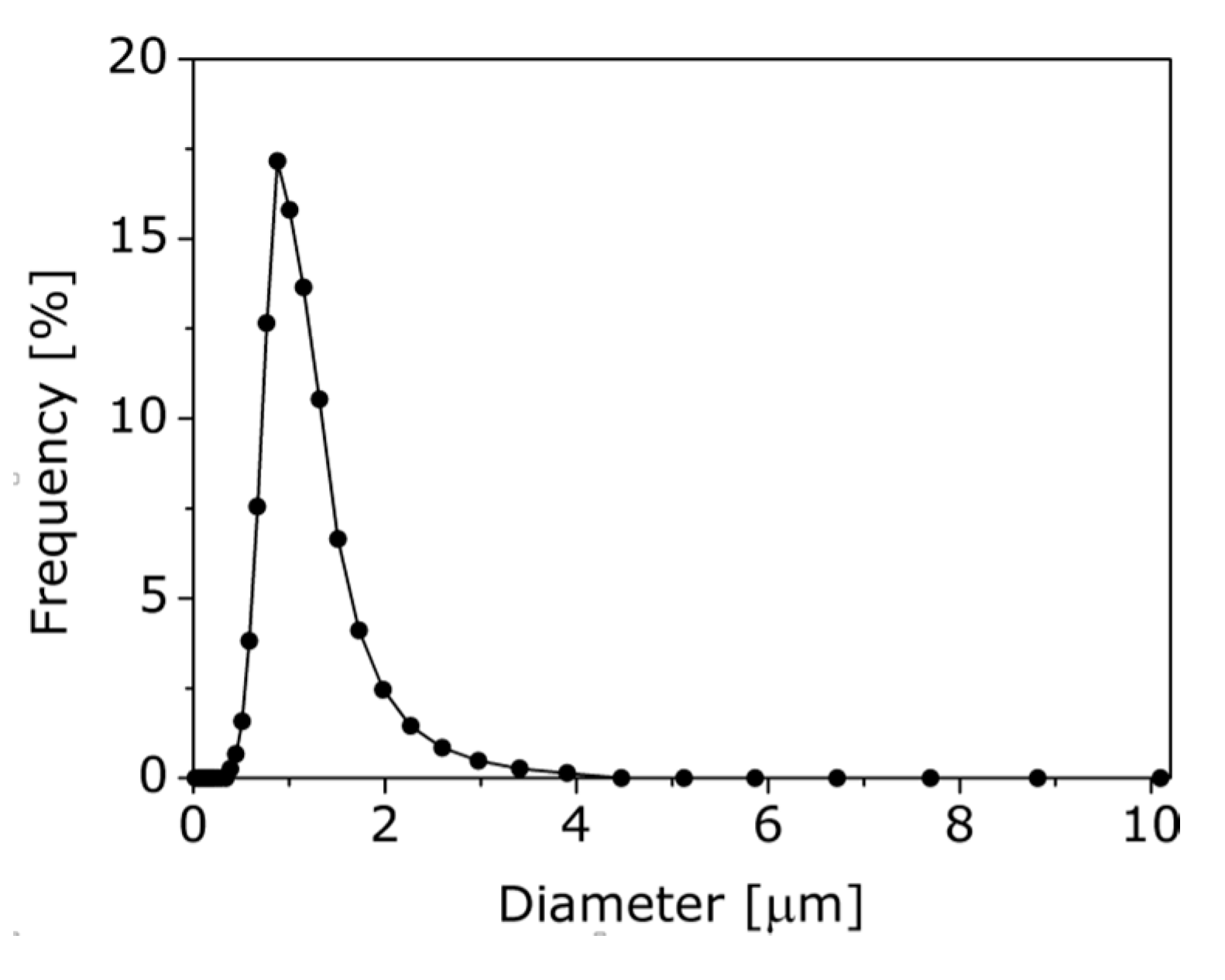
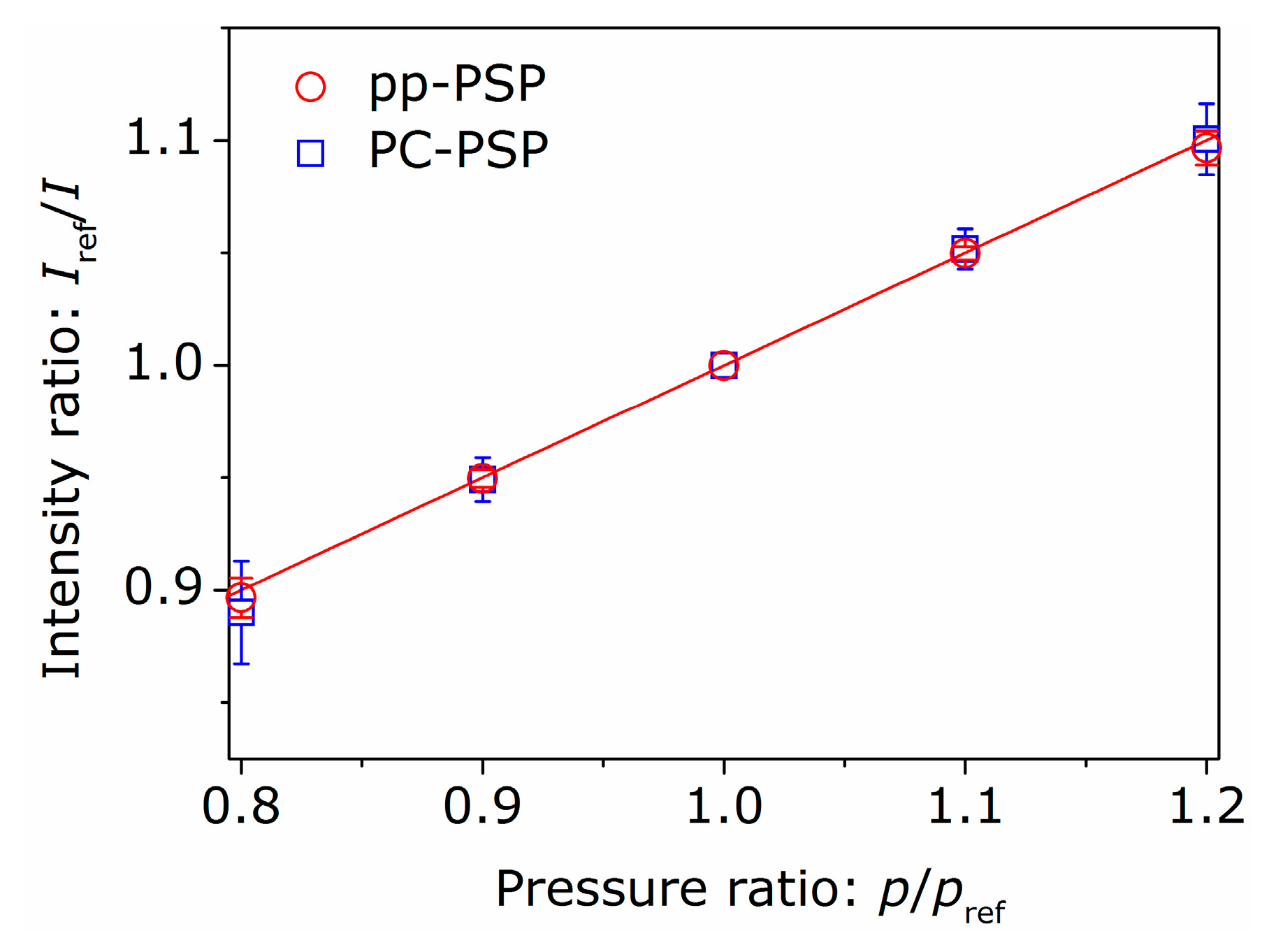
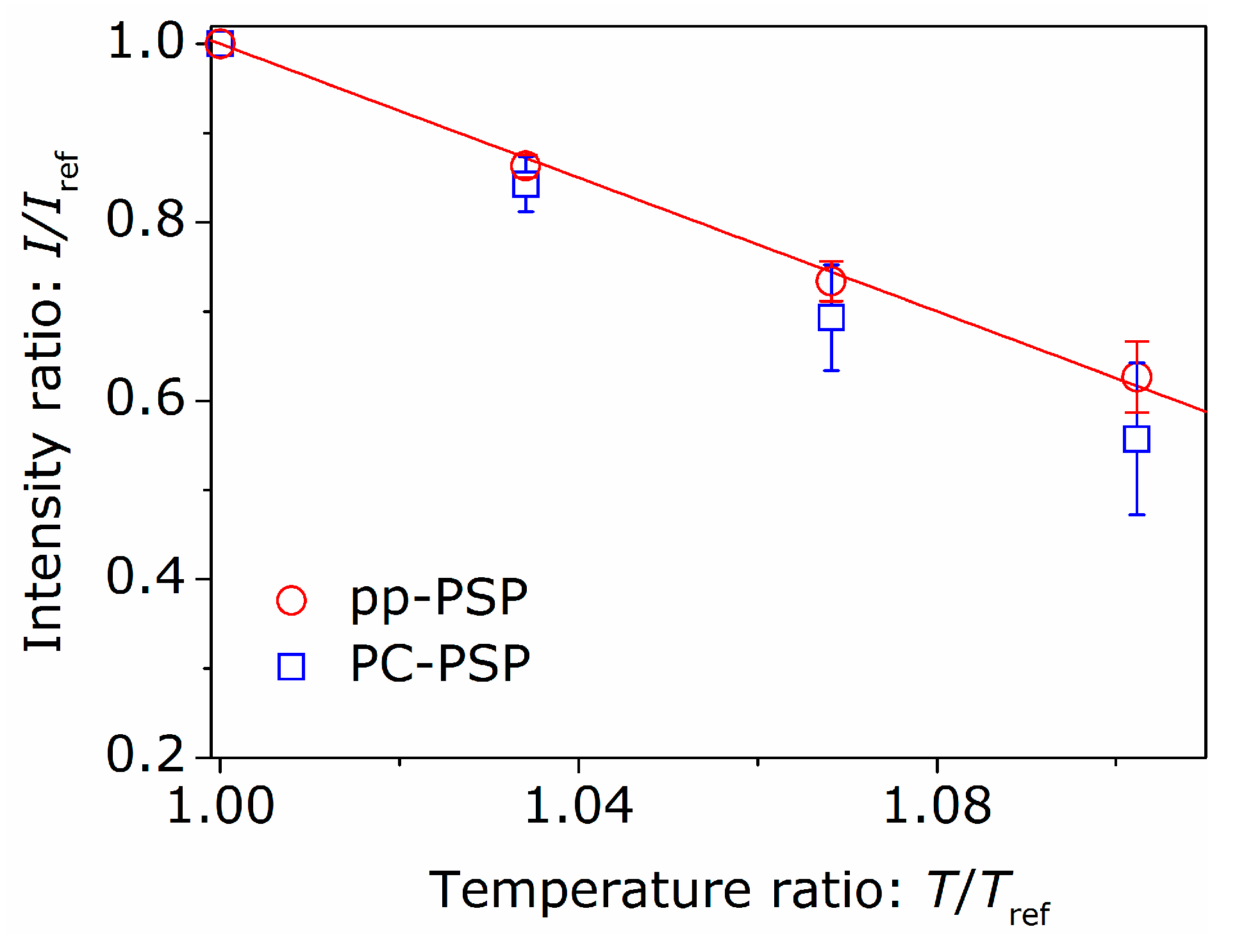
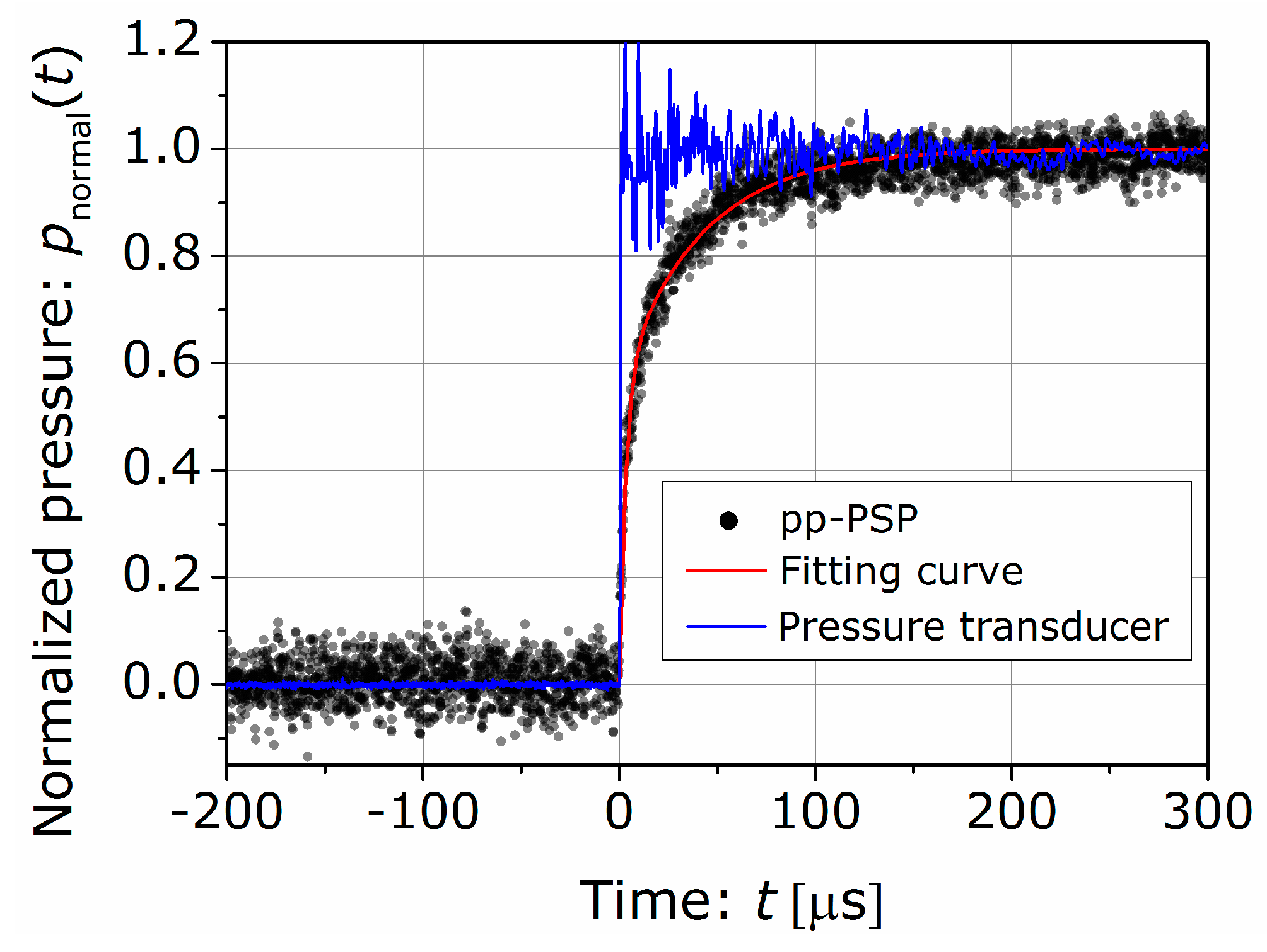
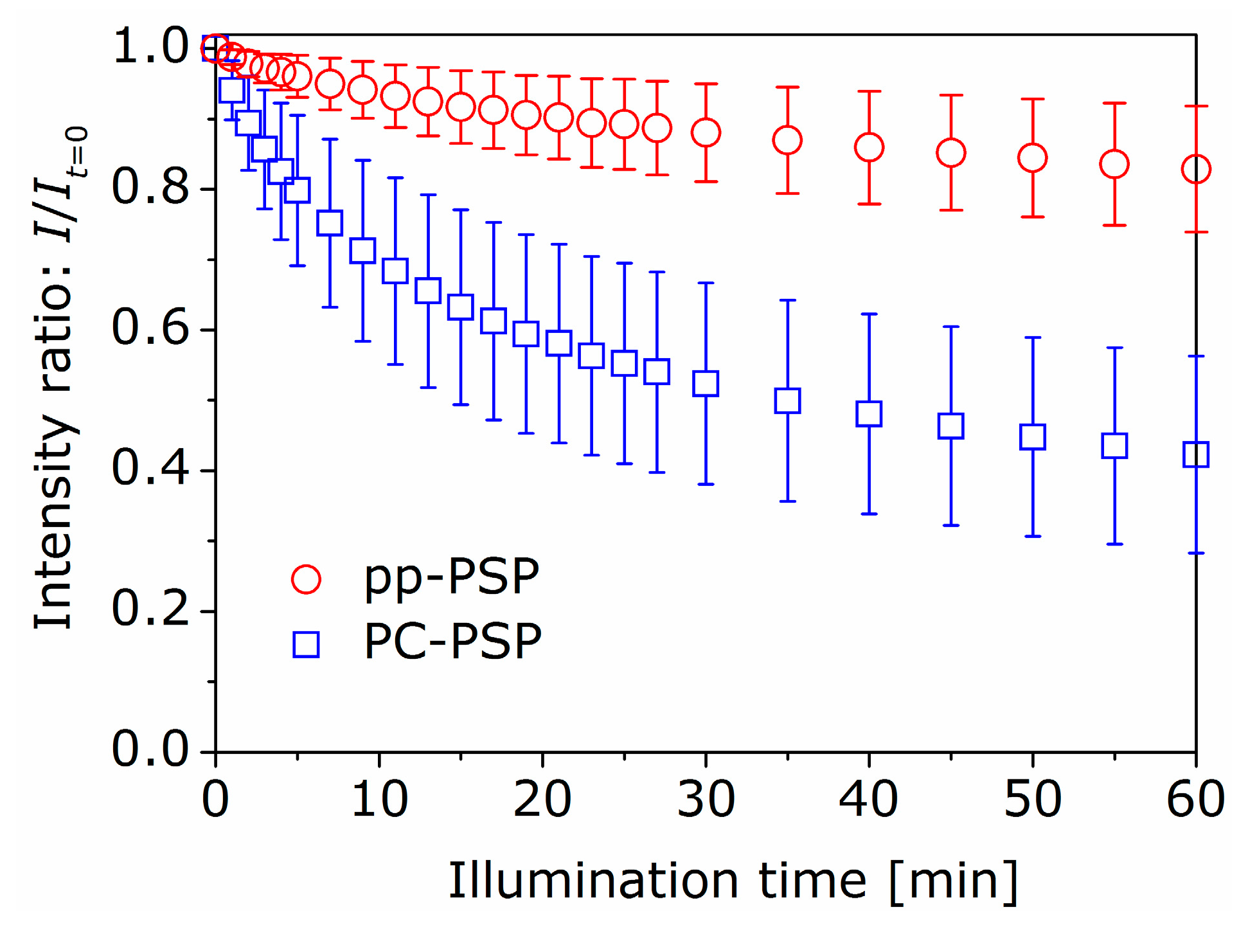
© 2016 by the authors; licensee MDPI, Basel, Switzerland. This article is an open access article distributed under the terms and conditions of the Creative Commons by Attribution (CC-BY) license (http://creativecommons.org/licenses/by/4.0/).
Share and Cite
Matsuda, Y.; Uchida, K.; Egami, Y.; Yamaguchi, H.; Niimi, T. Polymer-Particle Pressure-Sensitive Paint with High Photostability. Sensors 2016, 16, 550. https://doi.org/10.3390/s16040550
Matsuda Y, Uchida K, Egami Y, Yamaguchi H, Niimi T. Polymer-Particle Pressure-Sensitive Paint with High Photostability. Sensors. 2016; 16(4):550. https://doi.org/10.3390/s16040550
Chicago/Turabian StyleMatsuda, Yu, Kenta Uchida, Yasuhiro Egami, Hiroki Yamaguchi, and Tomohide Niimi. 2016. "Polymer-Particle Pressure-Sensitive Paint with High Photostability" Sensors 16, no. 4: 550. https://doi.org/10.3390/s16040550






